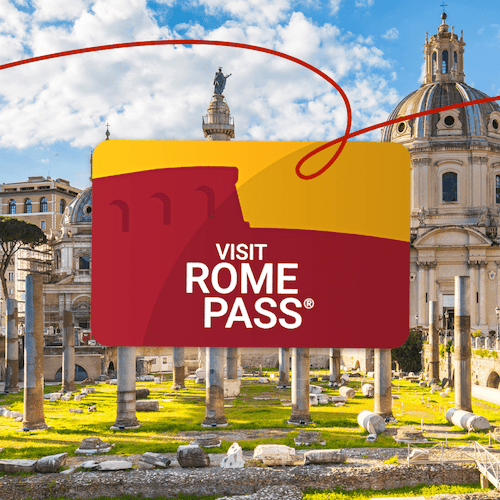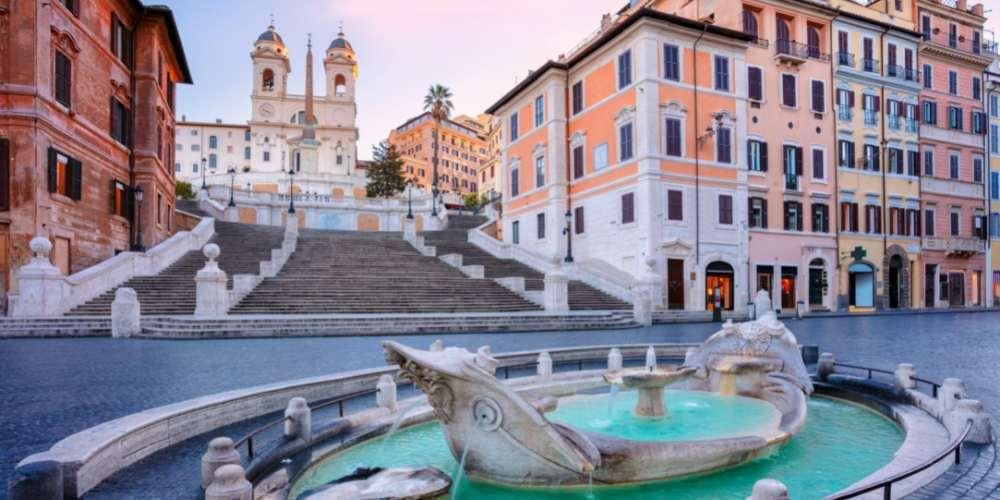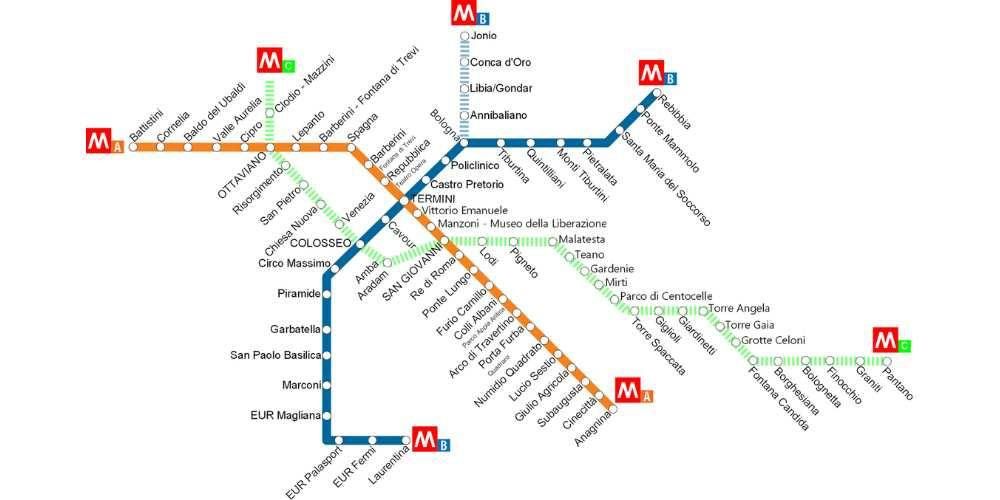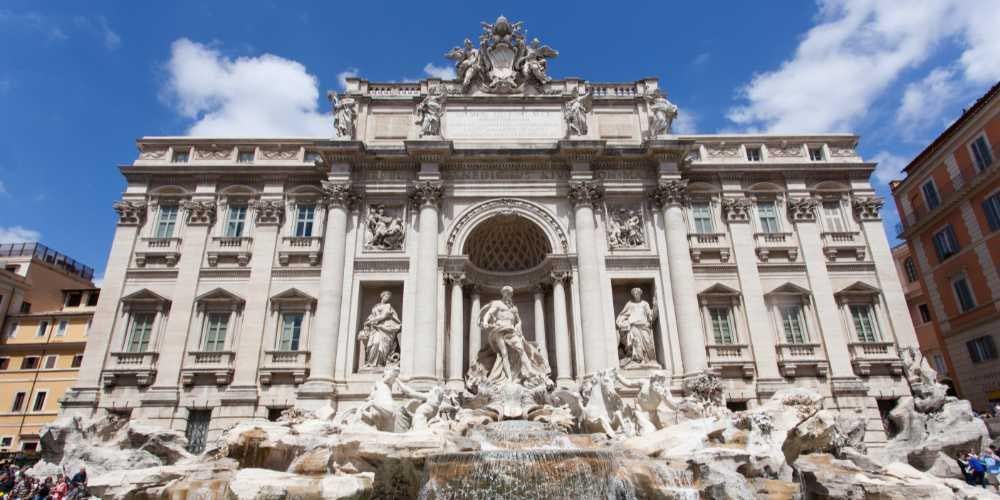Moving from one side to the other of a large metropolis like Rome, may seem like a difficult undertaking, and it certainly is, but in this article we will give you all the information you need to get around Rome by public transport, using the metro, buses, trams and railway lines; and you'll see that once you understand how it works it won't be that difficult.
In this article you will discover everything you need to know to get around Rome. A super guide to public transport with also an overview of the different types of tickets, season tickets and tourist passes that greatly facilitate travel around Rome. Among these, the Visit Rome Pass is highly recommended, a tourist pass which, in addition to access to more than 50 attractions, includes unlimited access to public transport.
Find out more about Visit Rome Pass
Public transport in Rome: everything you need to know to get around the capital
Knowing how to use Rome's public transport network is certainly the first step to enjoying your visit to the city to the fullest. First, we must consider that the center of Rome includes a very large surface area. The Colosseum and Roman Forum, for example, are in a very different area than the Vatican Museums or the Spanish Steps. It is therefore essential to plan, at least in principle, your daily itinerary. This allows you to understand more easily which public transports will be essential during the various excursions around Rome.
Subscriptions and passes come to our aid, which will allow you to organize your holiday in a comfortable and practical way. Are you ready to find out which public transport will be useful for your Roman Holidays? An alternative to public transport, to be considered if you plan trips out of town to pleasant but poorly connected places, is car rental. Vehicle that allows you to take personalized routes, outside the most tested circuits.
Buses and trams: the wide network of public transports in Rome
Buses and trams connect all areas of the capital, both in the center and on the outskirts.
There are 6 tram lines, active from 5.30 am to midnight:
- First of all, we mention line 8, because it is the most interesting from a tourist point of view: it connects Piazza Venezia (Fori Romani area) to Trastevere;
- Secondly, line 2 connects Piazza Mancini to Piazzale Flaminio;
- Line 3 connects Piazza Thorwaldsen and Trastevere;
- Line 5 connects Via Giovanni Amendola (Termini Station) to Piazza dei Gerani;
- Follow line 14 which connects Via Giovanni Amendola (Termini Station) to Palmiro Togliatti;
- Finally, line 19 connects Piazza Risorgimento to Piazza dei Gerani.
As for buses, the capital offers more than 300 daily lines and more than 20 night lines, counting over 8 thousand stops. Furthermore, a supply of 411 electric buses will arrive in the city by the end of 2024. The lines are active from 5.30 in the morning until midnight, and there are also a series of night bus lines active from midnight to 05.30 in the morning.
If, however, you like to be led, you could choose a panoramic bus tour and get off and on whenever you like at certain strategic points including: the Vatican and Castel Sant'Angelo, San Giovanni in Laterano, the Circus Maximus and many other places of interest.
Discover the panoramic bus tourMetro in Rome, your fastest choice
There are three metro lines: the first is Line A, characterized by the color Orange, with 27 stations, which connects Battistini to Anagnina, and runs 290 trips a day.
The second is Line B, characterized by the color Blue with 3 terminus: Laurentina, Rebibbia and Jonio and connects 26 stations with 308 trips per day.
The third Line C, marked by the green colour, is the most recent and is still partially under construction. The trains on this line are controlled and guided by a driverless integral automation system, therefore they do not have a driver on board. The line connects San Giovanni and Monte Compatri-Pantano. This line has an interesting history. In fact, during the construction works of the San Giovanni stop, numerous finds from the Roman era emerged which today are exhibited inside the station itself, used as a museum. The terminus of line C will be in Piazza Venezia, right in front of the Altare della Patria.
In general, the metro allows you to reach the main points of interest in the city such as the Spanish Steps, Piazza del Popolo, the Trevi Fountain, the Opera House, the Colosseum and St. Peter's Basilica. The subway is the most convenient and fastest way to move around the capital, used by tourists, but also by the Romans themselves. The metro operates every day from 5.30am to 11.30pm, while on Fridays and Saturdays until 1.30am.
If you travel by public transport it could be very useful to have an audio guide app on your phone, thanks to which you will be able to find constantly updated information on places of tourist importance, attractions, artistic masterpieces and treasures set like precious gems on the hills of Rome.
Discover the audio guide app for smartphonesTrainlines you can consider in Rome
On occasions, it may be interesting to consider trains. In fact, there are 12 railway lines in Rome! There are 8 main ones (whose names begin with the letter F) and 4 special ones.
The Atac company that manages Rome's public transport operates 3 lines that cover the routes from Rome to Viterbo, from Rome to Giardinetti and, finally, from Rome to Lido di Ostia. While the remaining 9 lines are managed by Trenitalia (Italian State Railways).
Among other lines, one of the most useful is the Leonardo Express, which connects Rome Termini station to Fiumicino airport. We then include the FL1 line (Orte – Fiumicino Airport), the FL2 (Rome Tiburtina – Tivoli), the FL3 (Rome Ostiense – Viterbo Porta Fiorentina), the FL4 (Rome Termini – Frascati / Albano Laziale / Velletri), the FL5 (Rome Termini – Civitavecchia), the FL6 (Rome Termini – Cassino), the FL7 (Rome Termini – Minturno - Scauri) and the FL8 (Rome Termini – Nettuno). It is certainly useful to know in which Rome airport to land at in order to secure a means of transport to enter the city. Remember that among the various alternatives available, you could rely on the fast and efficient minivan service for your travel from your hotel or from the center to Rome Fiumicino international airport.
After this overview, it is certainly clear that public transport in Rome is, to say the least, an indispensable tool for exploring all the beauties that the capital offers. We will see how to juggle tickets, season tickets and passes in the next paragraphs.
Discover the shuttle to/from Fiumicino airportThe ecological choice: moving by bike and on foot

The capital's cycle network extends for approximately 320 km and winds through parks and historic villas and along the main streets of Rome, encouraging the use of active and sustainable mobility not only in free time but also when traveling for work and study. The bike can represent a valid alternative to using public transport or private cars.
It is useful to know that it is allowed to ride public transport with your own folding or traditional bicycle. The folding bike is always free, while the traditional one is free only with Metrebus season tickets.
For some years now, to contribute to improving air quality, the city of Rome has pedestrianized some streets on specific days, on Sundays and on public holidays via dei Fori Imperiali and the stretch of the Appia Antica (from Porta San Sebastiano to the church of Domine Quo Vadis, and from via di San Sebastiano to Via Cecilia Metella) are accessible only to pedestrians and bicycles.
Experience Rome with an electric bikeHow to use the public transports in Rome: tickets and prices
As we have seen, the company that manages the capital's means of transport is Atac.
There are numerous solutions offered by Atac for the use of tickets which are valid not only for buses and trams, but also the underground and regional railways (in the latter case, the tickets are valid only in second class and on the Rome routes – Lido of Ostia, Termini - Centocelle, Rome - Viterbo).
Here are the proposed solutions:
- The single ticket, valid for 100 minutes from stamping (on the subway it is valid for a single journey and allows you to change lines A-B and A-C), at the price of 1.50 euros.
- The booklet includes 10 single tickets at a cost of 15 euros.
- There is an integrated weekly card, valid for 7 days starting from the moment of the first stamping which allows unlimited travel on public transport at a cost of 24 euros.
- Tickets: Rome 24h (7 euros); Rome 48h (12.50 euros) and Rome72h (18 euros).
Tickets can be purchased at tobacconists, newsstands, at the vending machines available at the main bus stops and at the metro stations, but also at the ATAC ticket offices and inside the train stations. Metro tickets can also be purchased via contactless credit card.
It may also be useful to know that children up to 10 years of age, if accompanied by a paying adult, have free access to the main public transport in the municipality of Rome.
It is always advisable to consult the ATAC official website to stay updated on any news or changes. Alternatively, some mobile applications are also available that provide solutions on routes, on connections between the different stops, on timetables and any delays: the main ones are Viaggia con Atac and Roma Mobilità, the official applications of the public transport company.
Tourist Pass to explore the capital of Italy: the most convenient solutions
In addition to single tickets, there are passes that allow unlimited travel on Rome's public transport lines for 48 and 72 hours. They are tourist-cultural cards, the counting will start from the moment of the first stamping and in addition to full access to public transport, the 48h card allows free entry to the first museum, archaeological site or experience; while the 72h card includes 2 free entries.
Finally, once again we suggest the Visit Rome Pass option, the advantage of this pass is that it includes access to more than 50 attractions combined with unlimited use of public transport, it is present in version 2, 3 or 7 days.
Discover the entry + public transport option for the Vatican, Colosseum, Roman ForumAbout the author
Written on 18/01/2023









Maria Vittoria Gardelli
Buses, metro, trams and even trains: discover the super guide with all the practical information for getting around Rome by public transport